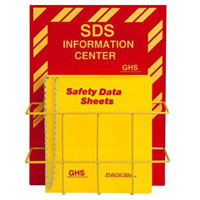 |
 |
| MSDS Topics |
Free Sites | FAQ's | Regulations | Glossary | Software | Suppliers |
| Books | Forum | Poll | Fun stuff | Quiz | Store | |
| MSDS and safety supplies | Search ALL our MSDS info | |||||
 | |||
 |
 |
 |
|
| Title: 12/02/2013 - Interim Guidance on Enforcement of the revised Hazard Communication Standard | |
| Record Type: Interpretation | Standard Number: 1910.1200(j)(1); 1910.1200(h); 1910.1200(h)(3)(iv) |
December 2, 2013
MEMORANDUM FOR: REGIONAL ADMINISTRATORS
THROUGH: DOROTHY DOUGHERTY, Acting Deputy Assistant Secretary
FROM: THOMAS GALASSI, Director, Directorate of Enforcement Programs
SUBJECT: Interim Guidance on Enforcement of the revised Hazard Communication Standard
Although the revised Hazard Communication Standard (HCS 2012) does not become fully implemented until June 1, 2016, some provisions are already in effect or will soon be in effect (e.g., training). Per 29 CFR 1910.1200(j)(1), by December 1, 2013, all employers whose employees are potentially exposed to hazardous chemicals must provide training on the revised HCS label elements and the new format and types of information on each section of safety data sheets (SDSs). The purpose of this training is to ensure that when employees begin to see HCS 2012 compliant labels and SDSs in their workplaces, they understand how to use them and access the information effectively. The Office of Health Enforcement is developing a revised Compliance Directive to outline procedures and policies for the new standard. This memo provides interim guidance to Compliance Safety and Health Officers (CSHOs) on the December 1, 2013, implementation date. Beginning December 2, 2013, if an employer has not provided the training required by the HCS, citations shall be issued for training deficiencies under 1910.1200(h) of HCS 2012. The following is a brief outline of the expectations on or after December 1, 2013, for all employers covered by the standard:
The National Office is also providing the attached frequently asked questions concerning the December 1, 2013, effective date. If you have any questions, please contact Mary Reynolds or Sven Rundman in the Office of Health Enforcement. Ms. Reynolds may be reached at reynolds.mary@dol.gov or 202-693-2187 and Mr. Rundman may be reached at rundman.sven@dol.gov or 202-693-2585.
Attachment
FREQUENTLY ASKED QUESTIONS ABOUT THE DECEMBER 1, 2013 IMPLEMENTATION DATE
No. HCS 2012 was published as a final rule on March 26, 2012, and therefore, employers were provided adequate time to create and implement this training. See 29 CFR 1910.1200(j), Effective Dates. Compliance Safety and Health Officers (CSHOs) may issue citations starting on December 2, 2013, for not providing this updated training.
The scope of the standard has not changed. All employees who are potentially exposed to hazardous chemicals during normal conditions of use or in a foreseeable emergency must be trained.
Employers need to address the label elements (product identifier, precautionary statements, hazard statements, pictograms, signal word, and manufacturer information), and the new SDS format (e.g., Section 8 is Exposure Controls/Personal Protection and will contain the PELs, TLVs, appropriate engineering controls and the recommended personal protective equipment). Employers also need to ensure that employees understand how to effectively access the appropriate hazard information on the updated labels and SDSs. This training supplements the rest of the employer's required HCS training, it is not a replacement.
Yes. This training ensures employees are aware of the new hazard information that manufacturers, importers and distributors will be providing under HCS 2012.

No. Employers must provide the updated training by December 1, 2013. There is no requirement to provide training on the new information prior to that date. This does not change the requirement to provide training to employees on the hazards of the chemicals to which employees are potentially exposed. CSHOs must follow the requirements of the CPL 02-02-038, Inspection Procedures for the Hazard Communication Standard, March 20, 1998 [now obsolete; view in context: CPL 2-2.38D | current regulation: CPL 02-02-079], concerning any training violation.
This implementation date does not affect any other training citation. CSHOs must follow CPL 2-2.38D, Inspection Procedures for the Hazard Communication Standard, March 20, 1998 [now obsolete; view in context: CPL 2-2.38D | current regulation: CPL 02-02-079], when evaluating training and issue citations according to the information outlined in the directive. After December 1, 2013, training on the label elements and SDS format must be included in all employers' Hazard Communication training.
A citation may not be issued for 1910.1200(j)(1); the citation must be issued under 1910.1200(h)(3)(iv).
The classification of the violation must be done in accordance with CPL 02-02-038, Inspection Procedures for the Hazard Communication Standard, March 20, 1998 [in context: CPL 2-2.38D | current regulation: CPL 02-02-079], and CPL 02-00-150, Field Operations Manual (FOM), April 22, 2011 [now obsolete; view in context: CPL 02-00-150 | current regulation: CPL02-00-159] . OSHA does not anticipate that the failure to train on the new SDS and label format would contribute to a potential serious exposure, and therefore would likely be classified as other-than-serious. However, if the training deficiency can contribute to a potential exposure capable of causing death or serious physical harm, the citation may be classified as serious.
There are 22 states and jurisdictions operating complete State Plans which cover both the private sector and state and local government employees, and five that cover state and local government employees only. Each State Plan must set occupational safety and health standards that are at least as effective as comparable federal standards. The majority of the State Plans have elected to adopt the revised Hazard Communications standard identically to OSHA's standard, which would include the December 1, 2013 training requirement. More information on the State Plans can be found at: http://www.osha.gov/dcsp/osp/index.html.
Information concerning HCS 2012 can be found at http://www.osha.gov/dsg/hazcom/index.html. On this page there is a fact sheet concerning the December 1, 2013 training requirements, two downloadable presentations concerning HCS 2012, links to webinars performed by OSHA staff, as well as other resources for the revised HCS.
The official, public domain, OSHA version of this document is available at http://www.osha.gov/pls/oshaweb/owadisp.show_document?p_table=INTERPRETATIONS&p_id=29240&p_text_version=FALSE